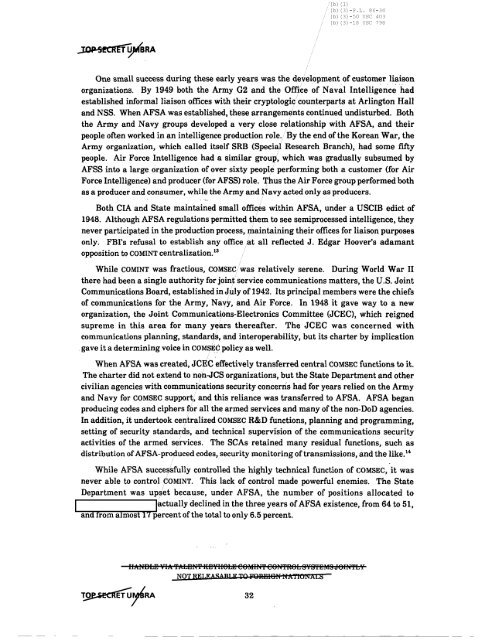American Cryptology during the Cold War - The Black Vault
American Cryptology during the Cold War - The Black Vault
American Cryptology during the Cold War - The Black Vault
You also want an ePaper? Increase the reach of your titles
YUMPU automatically turns print PDFs into web optimized ePapers that Google loves.
Ib) (1)<br />
Ib) (3) -P.L. 86-36<br />
Ib) (3) -50 USC 403<br />
Ib) (3) -18 USC 798<br />
One small success <strong>during</strong> <strong>the</strong>se early years was <strong>the</strong> development ofcustomer liaison<br />
organizations. By 1949 both <strong>the</strong> Army G2 and <strong>the</strong> Offrce of Naval Intelligence had<br />
established informal liaison offices with <strong>the</strong>ir cryptologic counterparts at Arlington Hall<br />
and NSS. When AFSA was established, <strong>the</strong>se arrangements continued undisturbed. Both<br />
<strong>the</strong> Army and Navy groups developed a very close relationship with AFSA, and <strong>the</strong>ir<br />
people often worked in an intelligence production role. By <strong>the</strong> end of <strong>the</strong> Korean <strong>War</strong>, <strong>the</strong><br />
Army organization, which called itself SRB (Special Research Branch), had some nfty<br />
people. Air Force Intelligence had a similar group, which was gradually subsumed by<br />
AFSS into a large organization of over sixty people performing both a customer (for Air<br />
Force Intelligence) and producer (for AFSS) role. Thus <strong>the</strong> Air Force group performed both<br />
as a producer and consumer, while <strong>the</strong> Army and N"avy acted only as producers.<br />
Both CIA and State maintained small offices within AFSA, under a USCIB edict of<br />
1948. Although AFSA regulations permitted <strong>the</strong>m to see semiprocessed intelligence, <strong>the</strong>y<br />
never participated in <strong>the</strong> production process, maintaining <strong>the</strong>ir offices for liaison purposes<br />
only. FBI's refusal to establish any office at all reflected J. Edgar Hoover's adamant<br />
opposition to COMINT centralization. 13<br />
While COMINT was fractious, COMSEC/was relatively serene. During World <strong>War</strong> II<br />
<strong>the</strong>re had been a single authority for joint service communications matters, <strong>the</strong> U.S. Joint<br />
Communications Board, established in July of1942. Its principal members were <strong>the</strong> chiefs<br />
of communications for <strong>the</strong> Army, Navy, and Air Force. In 1948 it gave way to a new<br />
organization, <strong>the</strong> Joint CommunicaWms-Electronics Committee (JCEC), which reigned<br />
supreme in this area for many years <strong>the</strong>reafter. <strong>The</strong> JCEC was concerned with<br />
communications planning, standards, and interoperability, but its charter by implication<br />
gave ita determining voice in COMSEC policy as well.<br />
When AFSA was created, JCEC effectively transferred central COMSEC functions to it.<br />
<strong>The</strong> charter did not extend to non.JCS organizations, but <strong>the</strong> State Department and o<strong>the</strong>r<br />
civilian agencies with communIcations security concerns had for years relied on <strong>the</strong> Army<br />
and Navy for COMSEC support., and this reliance was transferred to AFSA. AFSA began<br />
producing codes and ciphers for all <strong>the</strong> armed services and many of <strong>the</strong> non-DoD agencies.<br />
In addition, it undertook centralized COMSEC R&D functions, planning and programming,<br />
setting of security standards, and technical supervision of <strong>the</strong> communications security<br />
activities of <strong>the</strong> armed services. <strong>The</strong> SCAs retained many residual functions, such as<br />
distribution ofAFSA-produced codes, security monitoring oftransmissions, and <strong>the</strong> like. 14<br />
While AFSA successfully controlled <strong>the</strong> highly technical function of COMSEC, it was<br />
never able to control COMINT. This lack of control made powerful enemies. <strong>The</strong> State<br />
Department was upset because, under AFSA, <strong>the</strong> number of positions allocated to<br />
I lactually declined in <strong>the</strong> three years ofAFSA existence, from 64 to 51,<br />
and trom almost 1'1 percent of <strong>the</strong> total to only 6.5 percent.<br />
nA:UBtiB YIA ~tiBU'fIEBYUStiB eSMUii'f eSN'fRsr:: SYS'fBMStJSIU'fti7<br />
NOT RELEASABI E TO ~~I8!, UkYI('JNAtS<br />
32<br />
-- ---- ------------------------
















